Beaver Fur Hat: A Historical Artifact of Canadian History
VerifiedAdded on 2023/04/23
|7
|1560
|405
AI Summary
This assignment explores the historical significance of Beaver Fur Hat, a fashionable item during the 18th to 19th century in Europe, made from beavers from coat and parchment. It describes the artifact, its material, historical context, makers and users, and its significance to Canadian history. It also analyzes its political, economic, social, cultural, or environmental impacts.
Contribute Materials
Your contribution can guide someone’s learning journey. Share your
documents today.
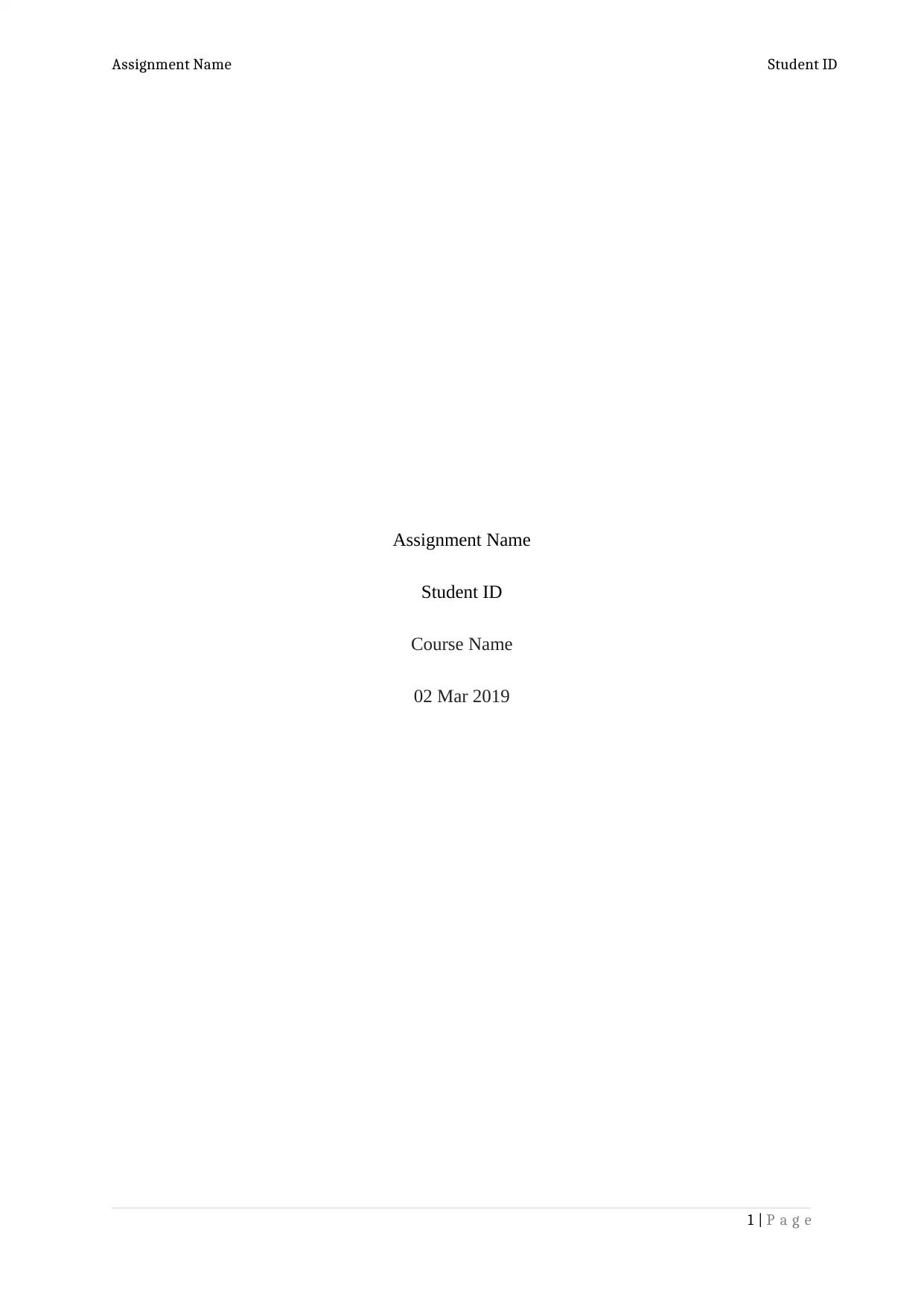
Assignment Name Student ID
Assignment Name
Student ID
Course Name
02 Mar 2019
1 | P a g e
Assignment Name
Student ID
Course Name
02 Mar 2019
1 | P a g e
Secure Best Marks with AI Grader
Need help grading? Try our AI Grader for instant feedback on your assignments.
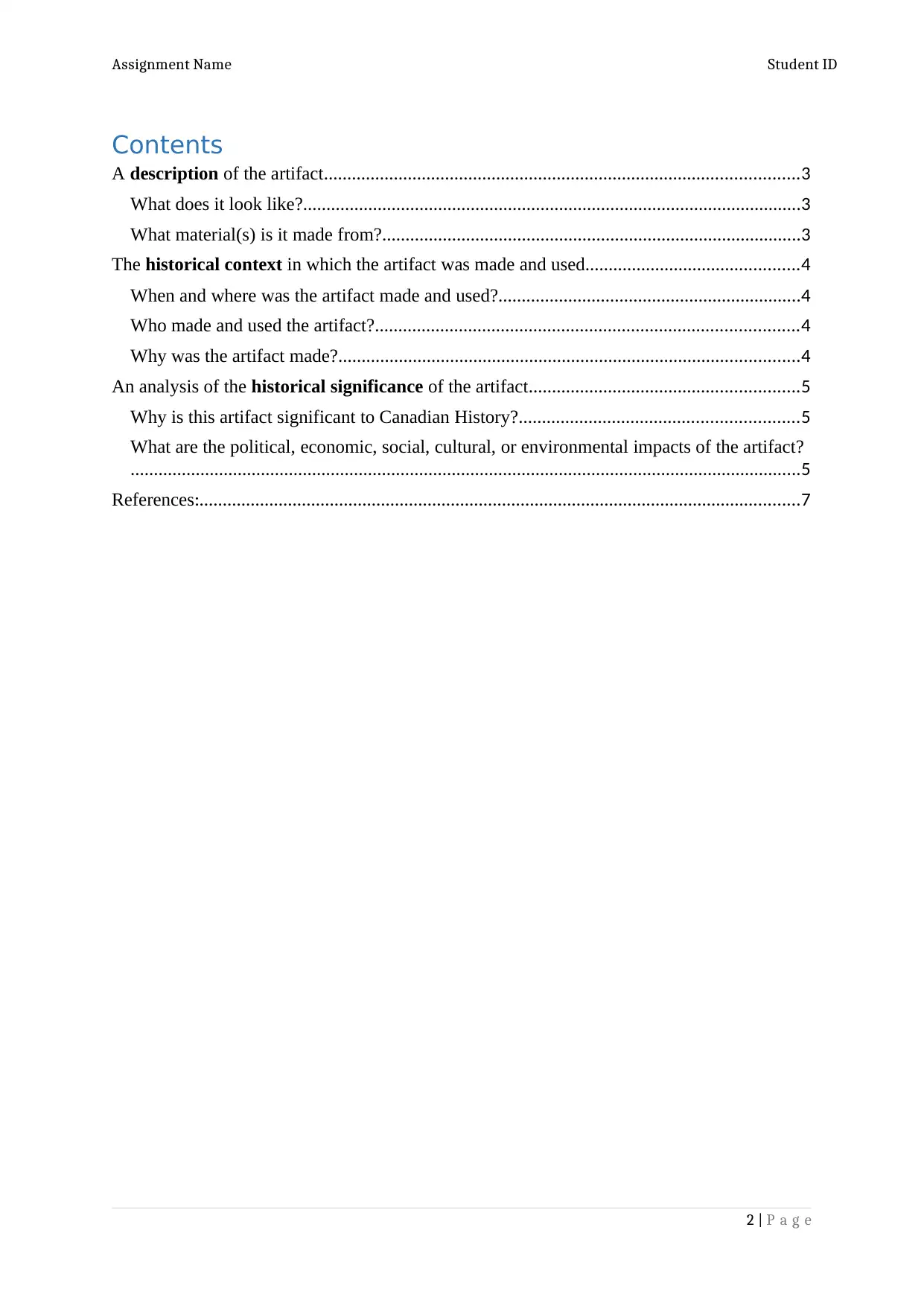
Assignment Name Student ID
Contents
A description of the artifact......................................................................................................3
What does it look like?...........................................................................................................3
What material(s) is it made from?..........................................................................................3
The historical context in which the artifact was made and used..............................................4
When and where was the artifact made and used?.................................................................4
Who made and used the artifact?...........................................................................................4
Why was the artifact made?...................................................................................................4
An analysis of the historical significance of the artifact..........................................................5
Why is this artifact significant to Canadian History?............................................................5
What are the political, economic, social, cultural, or environmental impacts of the artifact?
................................................................................................................................................5
References:.................................................................................................................................7
2 | P a g e
Contents
A description of the artifact......................................................................................................3
What does it look like?...........................................................................................................3
What material(s) is it made from?..........................................................................................3
The historical context in which the artifact was made and used..............................................4
When and where was the artifact made and used?.................................................................4
Who made and used the artifact?...........................................................................................4
Why was the artifact made?...................................................................................................4
An analysis of the historical significance of the artifact..........................................................5
Why is this artifact significant to Canadian History?............................................................5
What are the political, economic, social, cultural, or environmental impacts of the artifact?
................................................................................................................................................5
References:.................................................................................................................................7
2 | P a g e
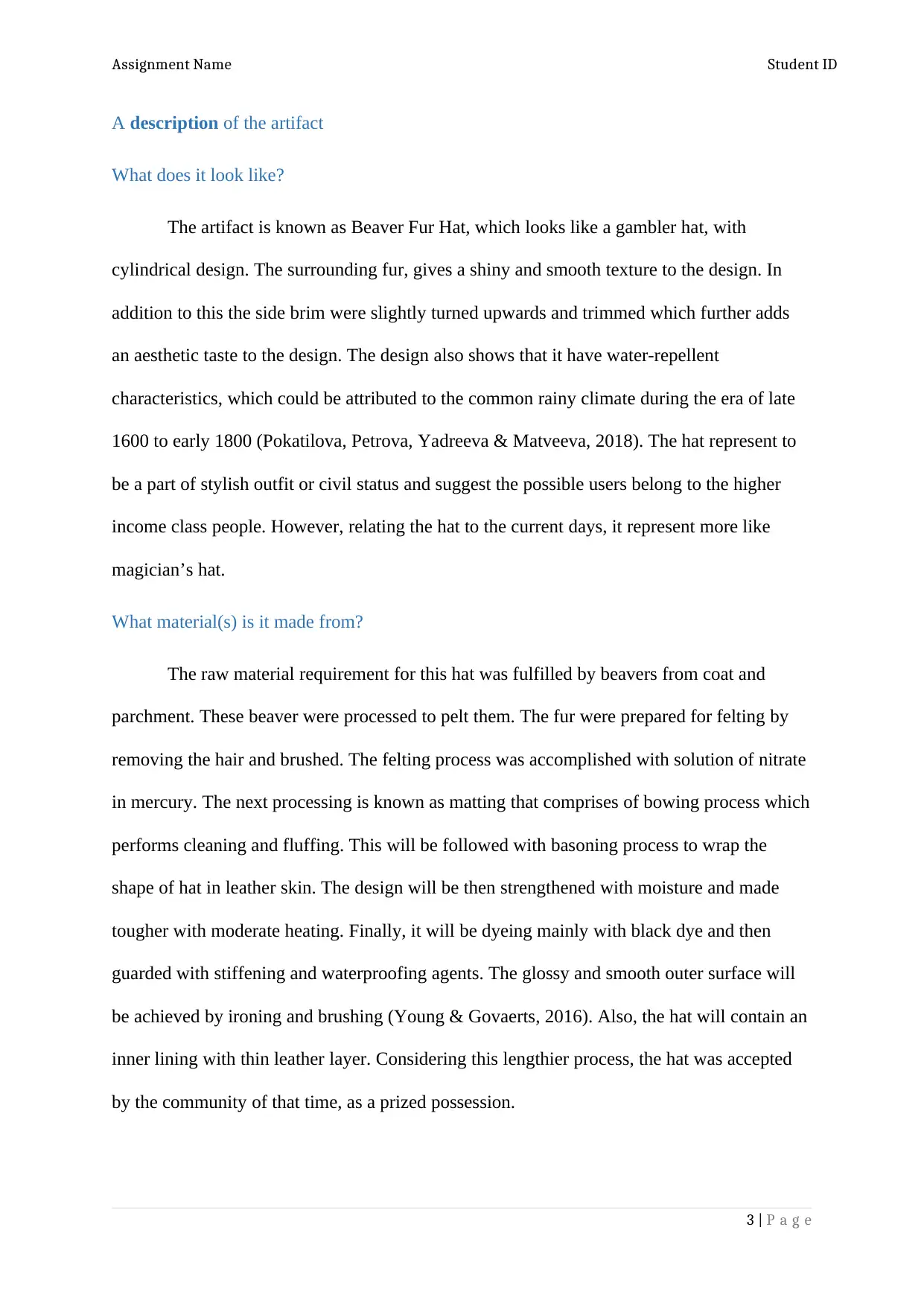
Assignment Name Student ID
A description of the artifact
What does it look like?
The artifact is known as Beaver Fur Hat, which looks like a gambler hat, with
cylindrical design. The surrounding fur, gives a shiny and smooth texture to the design. In
addition to this the side brim were slightly turned upwards and trimmed which further adds
an aesthetic taste to the design. The design also shows that it have water-repellent
characteristics, which could be attributed to the common rainy climate during the era of late
1600 to early 1800 (Pokatilova, Petrova, Yadreeva & Matveeva, 2018). The hat represent to
be a part of stylish outfit or civil status and suggest the possible users belong to the higher
income class people. However, relating the hat to the current days, it represent more like
magician’s hat.
What material(s) is it made from?
The raw material requirement for this hat was fulfilled by beavers from coat and
parchment. These beaver were processed to pelt them. The fur were prepared for felting by
removing the hair and brushed. The felting process was accomplished with solution of nitrate
in mercury. The next processing is known as matting that comprises of bowing process which
performs cleaning and fluffing. This will be followed with basoning process to wrap the
shape of hat in leather skin. The design will be then strengthened with moisture and made
tougher with moderate heating. Finally, it will be dyeing mainly with black dye and then
guarded with stiffening and waterproofing agents. The glossy and smooth outer surface will
be achieved by ironing and brushing (Young & Govaerts, 2016). Also, the hat will contain an
inner lining with thin leather layer. Considering this lengthier process, the hat was accepted
by the community of that time, as a prized possession.
3 | P a g e
A description of the artifact
What does it look like?
The artifact is known as Beaver Fur Hat, which looks like a gambler hat, with
cylindrical design. The surrounding fur, gives a shiny and smooth texture to the design. In
addition to this the side brim were slightly turned upwards and trimmed which further adds
an aesthetic taste to the design. The design also shows that it have water-repellent
characteristics, which could be attributed to the common rainy climate during the era of late
1600 to early 1800 (Pokatilova, Petrova, Yadreeva & Matveeva, 2018). The hat represent to
be a part of stylish outfit or civil status and suggest the possible users belong to the higher
income class people. However, relating the hat to the current days, it represent more like
magician’s hat.
What material(s) is it made from?
The raw material requirement for this hat was fulfilled by beavers from coat and
parchment. These beaver were processed to pelt them. The fur were prepared for felting by
removing the hair and brushed. The felting process was accomplished with solution of nitrate
in mercury. The next processing is known as matting that comprises of bowing process which
performs cleaning and fluffing. This will be followed with basoning process to wrap the
shape of hat in leather skin. The design will be then strengthened with moisture and made
tougher with moderate heating. Finally, it will be dyeing mainly with black dye and then
guarded with stiffening and waterproofing agents. The glossy and smooth outer surface will
be achieved by ironing and brushing (Young & Govaerts, 2016). Also, the hat will contain an
inner lining with thin leather layer. Considering this lengthier process, the hat was accepted
by the community of that time, as a prized possession.
3 | P a g e
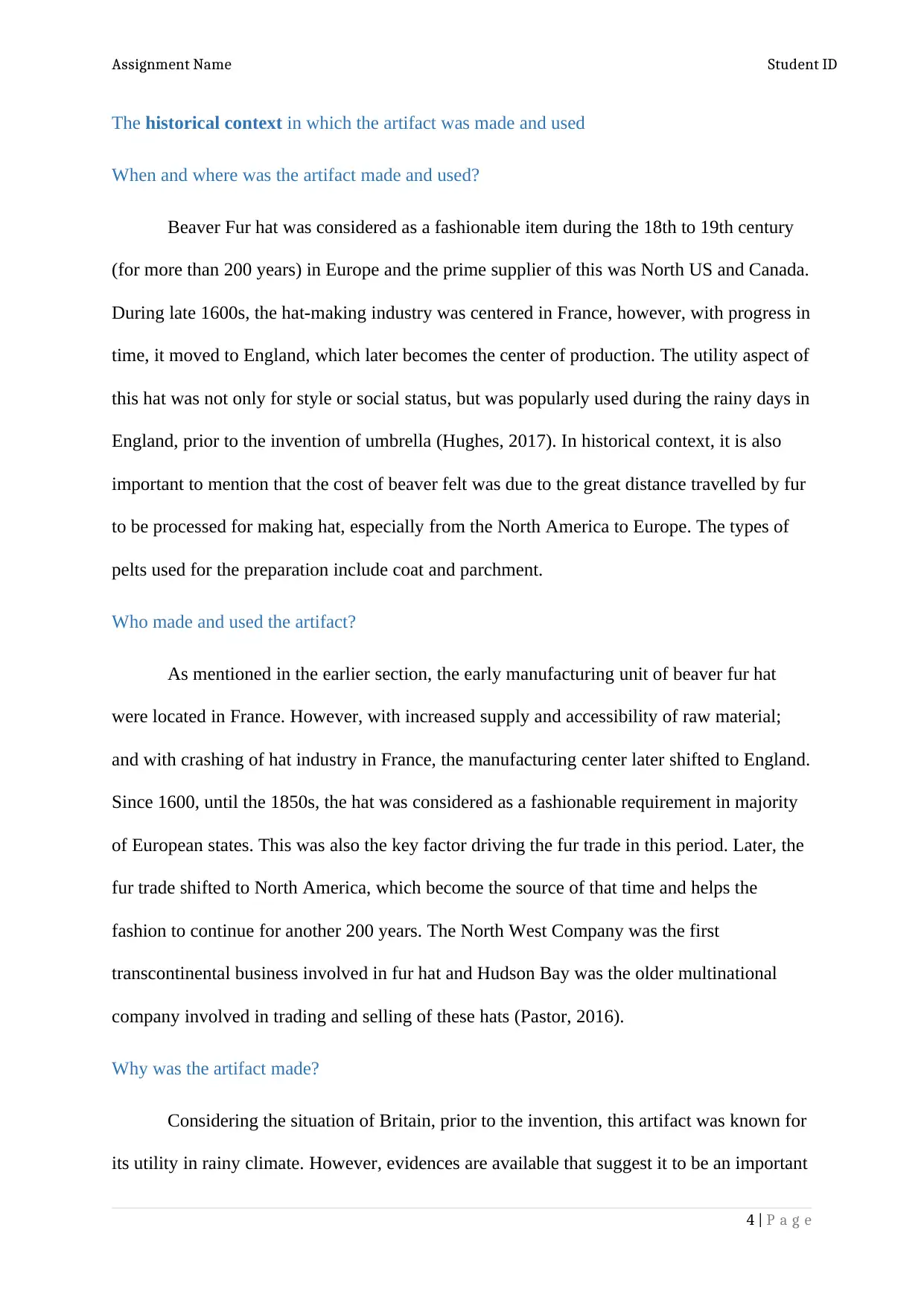
Assignment Name Student ID
The historical context in which the artifact was made and used
When and where was the artifact made and used?
Beaver Fur hat was considered as a fashionable item during the 18th to 19th century
(for more than 200 years) in Europe and the prime supplier of this was North US and Canada.
During late 1600s, the hat-making industry was centered in France, however, with progress in
time, it moved to England, which later becomes the center of production. The utility aspect of
this hat was not only for style or social status, but was popularly used during the rainy days in
England, prior to the invention of umbrella (Hughes, 2017). In historical context, it is also
important to mention that the cost of beaver felt was due to the great distance travelled by fur
to be processed for making hat, especially from the North America to Europe. The types of
pelts used for the preparation include coat and parchment.
Who made and used the artifact?
As mentioned in the earlier section, the early manufacturing unit of beaver fur hat
were located in France. However, with increased supply and accessibility of raw material;
and with crashing of hat industry in France, the manufacturing center later shifted to England.
Since 1600, until the 1850s, the hat was considered as a fashionable requirement in majority
of European states. This was also the key factor driving the fur trade in this period. Later, the
fur trade shifted to North America, which become the source of that time and helps the
fashion to continue for another 200 years. The North West Company was the first
transcontinental business involved in fur hat and Hudson Bay was the older multinational
company involved in trading and selling of these hats (Pastor, 2016).
Why was the artifact made?
Considering the situation of Britain, prior to the invention, this artifact was known for
its utility in rainy climate. However, evidences are available that suggest it to be an important
4 | P a g e
The historical context in which the artifact was made and used
When and where was the artifact made and used?
Beaver Fur hat was considered as a fashionable item during the 18th to 19th century
(for more than 200 years) in Europe and the prime supplier of this was North US and Canada.
During late 1600s, the hat-making industry was centered in France, however, with progress in
time, it moved to England, which later becomes the center of production. The utility aspect of
this hat was not only for style or social status, but was popularly used during the rainy days in
England, prior to the invention of umbrella (Hughes, 2017). In historical context, it is also
important to mention that the cost of beaver felt was due to the great distance travelled by fur
to be processed for making hat, especially from the North America to Europe. The types of
pelts used for the preparation include coat and parchment.
Who made and used the artifact?
As mentioned in the earlier section, the early manufacturing unit of beaver fur hat
were located in France. However, with increased supply and accessibility of raw material;
and with crashing of hat industry in France, the manufacturing center later shifted to England.
Since 1600, until the 1850s, the hat was considered as a fashionable requirement in majority
of European states. This was also the key factor driving the fur trade in this period. Later, the
fur trade shifted to North America, which become the source of that time and helps the
fashion to continue for another 200 years. The North West Company was the first
transcontinental business involved in fur hat and Hudson Bay was the older multinational
company involved in trading and selling of these hats (Pastor, 2016).
Why was the artifact made?
Considering the situation of Britain, prior to the invention, this artifact was known for
its utility in rainy climate. However, evidences are available that suggest it to be an important
4 | P a g e
Secure Best Marks with AI Grader
Need help grading? Try our AI Grader for instant feedback on your assignments.
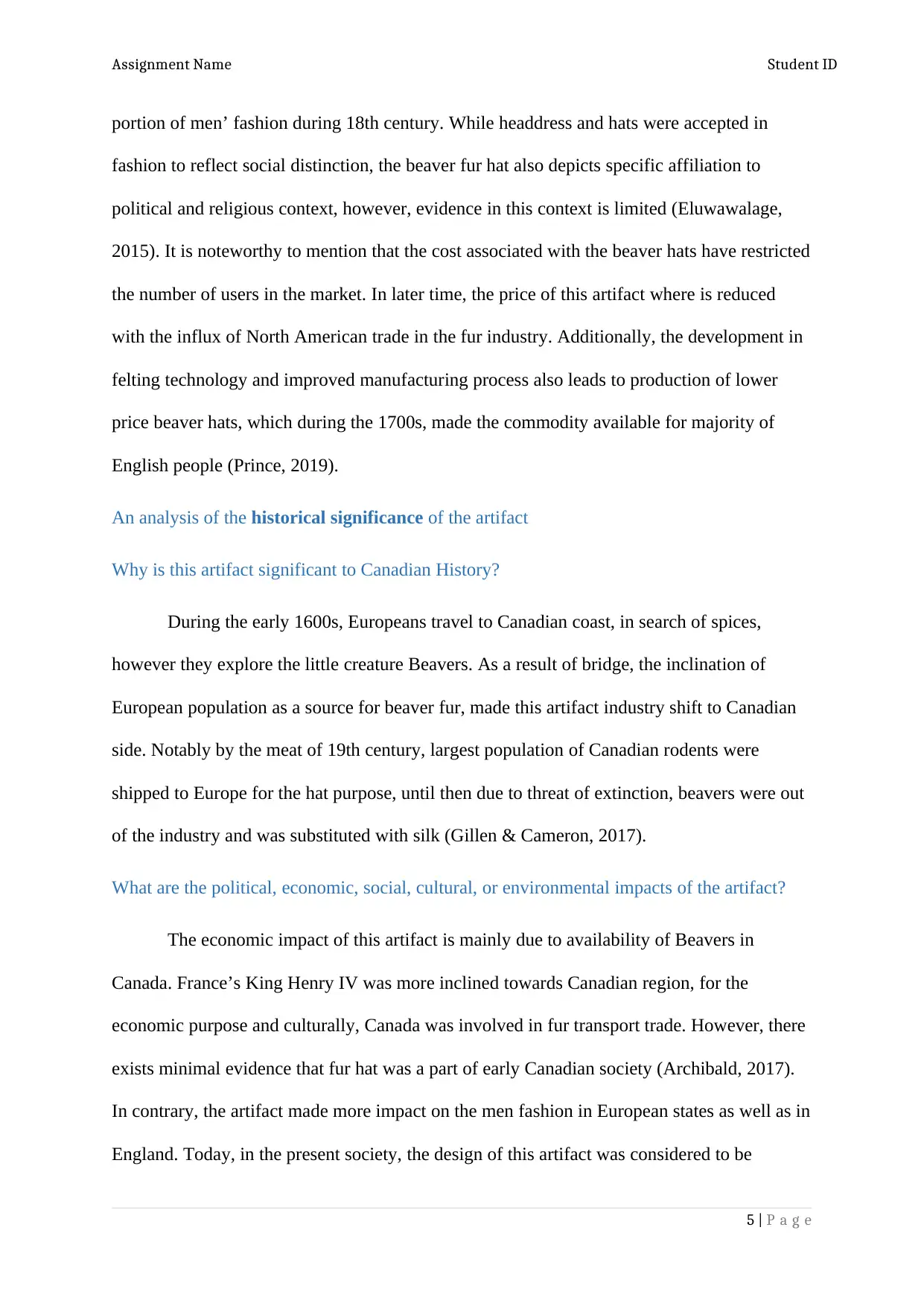
Assignment Name Student ID
portion of men’ fashion during 18th century. While headdress and hats were accepted in
fashion to reflect social distinction, the beaver fur hat also depicts specific affiliation to
political and religious context, however, evidence in this context is limited (Eluwawalage,
2015). It is noteworthy to mention that the cost associated with the beaver hats have restricted
the number of users in the market. In later time, the price of this artifact where is reduced
with the influx of North American trade in the fur industry. Additionally, the development in
felting technology and improved manufacturing process also leads to production of lower
price beaver hats, which during the 1700s, made the commodity available for majority of
English people (Prince, 2019).
An analysis of the historical significance of the artifact
Why is this artifact significant to Canadian History?
During the early 1600s, Europeans travel to Canadian coast, in search of spices,
however they explore the little creature Beavers. As a result of bridge, the inclination of
European population as a source for beaver fur, made this artifact industry shift to Canadian
side. Notably by the meat of 19th century, largest population of Canadian rodents were
shipped to Europe for the hat purpose, until then due to threat of extinction, beavers were out
of the industry and was substituted with silk (Gillen & Cameron, 2017).
What are the political, economic, social, cultural, or environmental impacts of the artifact?
The economic impact of this artifact is mainly due to availability of Beavers in
Canada. France’s King Henry IV was more inclined towards Canadian region, for the
economic purpose and culturally, Canada was involved in fur transport trade. However, there
exists minimal evidence that fur hat was a part of early Canadian society (Archibald, 2017).
In contrary, the artifact made more impact on the men fashion in European states as well as in
England. Today, in the present society, the design of this artifact was considered to be
5 | P a g e
portion of men’ fashion during 18th century. While headdress and hats were accepted in
fashion to reflect social distinction, the beaver fur hat also depicts specific affiliation to
political and religious context, however, evidence in this context is limited (Eluwawalage,
2015). It is noteworthy to mention that the cost associated with the beaver hats have restricted
the number of users in the market. In later time, the price of this artifact where is reduced
with the influx of North American trade in the fur industry. Additionally, the development in
felting technology and improved manufacturing process also leads to production of lower
price beaver hats, which during the 1700s, made the commodity available for majority of
English people (Prince, 2019).
An analysis of the historical significance of the artifact
Why is this artifact significant to Canadian History?
During the early 1600s, Europeans travel to Canadian coast, in search of spices,
however they explore the little creature Beavers. As a result of bridge, the inclination of
European population as a source for beaver fur, made this artifact industry shift to Canadian
side. Notably by the meat of 19th century, largest population of Canadian rodents were
shipped to Europe for the hat purpose, until then due to threat of extinction, beavers were out
of the industry and was substituted with silk (Gillen & Cameron, 2017).
What are the political, economic, social, cultural, or environmental impacts of the artifact?
The economic impact of this artifact is mainly due to availability of Beavers in
Canada. France’s King Henry IV was more inclined towards Canadian region, for the
economic purpose and culturally, Canada was involved in fur transport trade. However, there
exists minimal evidence that fur hat was a part of early Canadian society (Archibald, 2017).
In contrary, the artifact made more impact on the men fashion in European states as well as in
England. Today, in the present society, the design of this artifact was considered to be
5 | P a g e
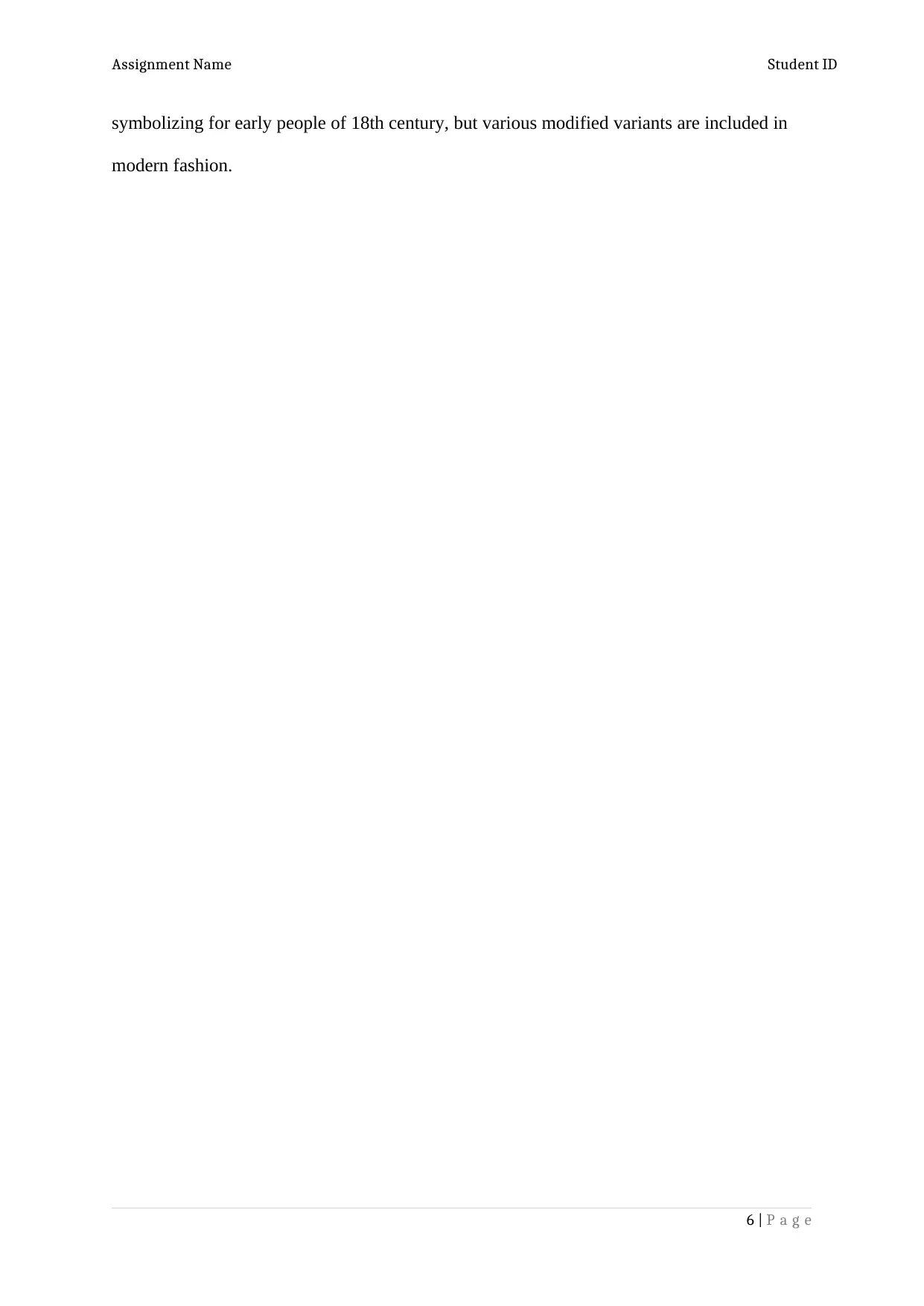
Assignment Name Student ID
symbolizing for early people of 18th century, but various modified variants are included in
modern fashion.
6 | P a g e
symbolizing for early people of 18th century, but various modified variants are included in
modern fashion.
6 | P a g e
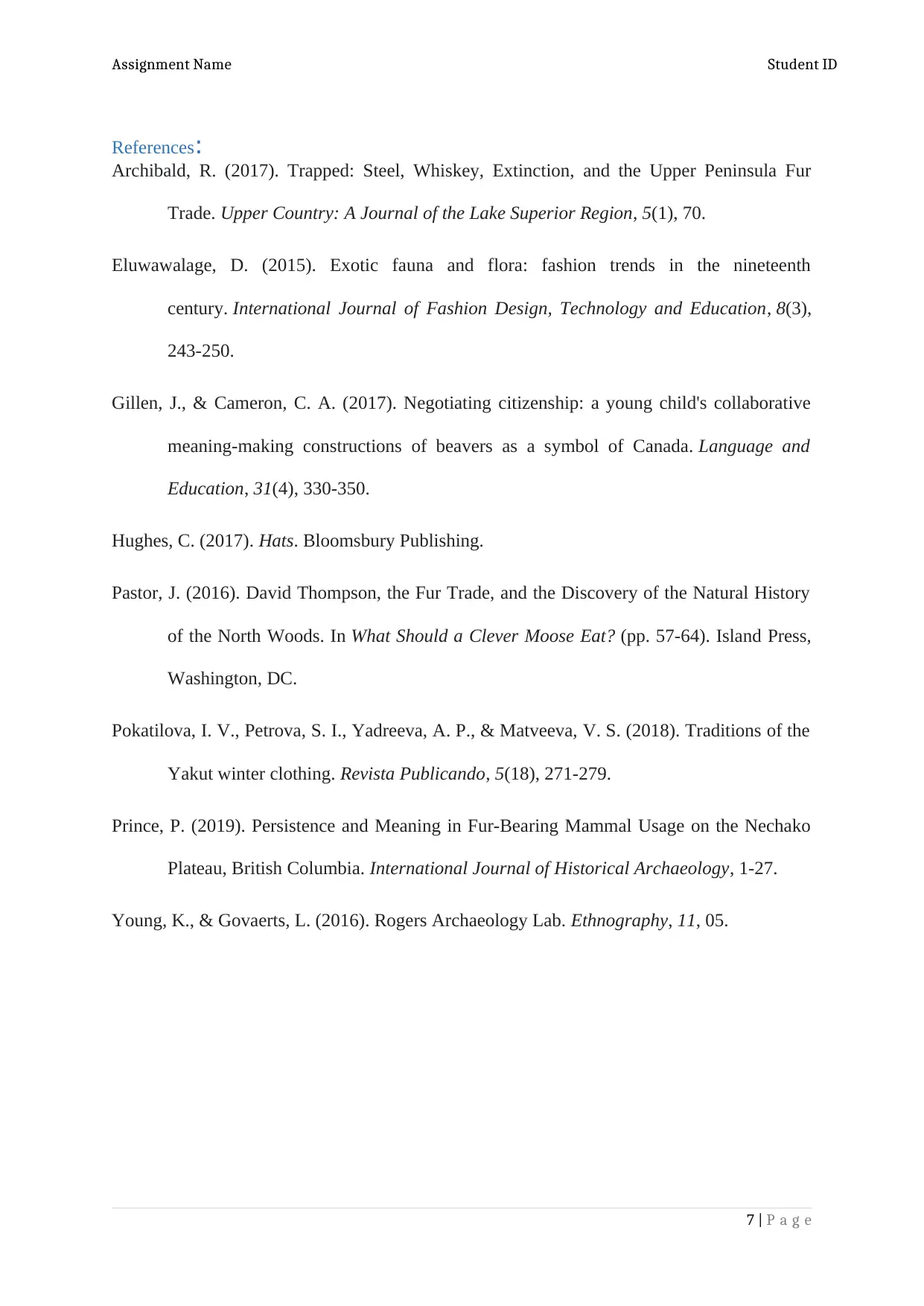
Assignment Name Student ID
References:
Archibald, R. (2017). Trapped: Steel, Whiskey, Extinction, and the Upper Peninsula Fur
Trade. Upper Country: A Journal of the Lake Superior Region, 5(1), 70.
Eluwawalage, D. (2015). Exotic fauna and flora: fashion trends in the nineteenth
century. International Journal of Fashion Design, Technology and Education, 8(3),
243-250.
Gillen, J., & Cameron, C. A. (2017). Negotiating citizenship: a young child's collaborative
meaning-making constructions of beavers as a symbol of Canada. Language and
Education, 31(4), 330-350.
Hughes, C. (2017). Hats. Bloomsbury Publishing.
Pastor, J. (2016). David Thompson, the Fur Trade, and the Discovery of the Natural History
of the North Woods. In What Should a Clever Moose Eat? (pp. 57-64). Island Press,
Washington, DC.
Pokatilova, I. V., Petrova, S. I., Yadreeva, A. P., & Matveeva, V. S. (2018). Traditions of the
Yakut winter clothing. Revista Publicando, 5(18), 271-279.
Prince, P. (2019). Persistence and Meaning in Fur-Bearing Mammal Usage on the Nechako
Plateau, British Columbia. International Journal of Historical Archaeology, 1-27.
Young, K., & Govaerts, L. (2016). Rogers Archaeology Lab. Ethnography, 11, 05.
7 | P a g e
References:
Archibald, R. (2017). Trapped: Steel, Whiskey, Extinction, and the Upper Peninsula Fur
Trade. Upper Country: A Journal of the Lake Superior Region, 5(1), 70.
Eluwawalage, D. (2015). Exotic fauna and flora: fashion trends in the nineteenth
century. International Journal of Fashion Design, Technology and Education, 8(3),
243-250.
Gillen, J., & Cameron, C. A. (2017). Negotiating citizenship: a young child's collaborative
meaning-making constructions of beavers as a symbol of Canada. Language and
Education, 31(4), 330-350.
Hughes, C. (2017). Hats. Bloomsbury Publishing.
Pastor, J. (2016). David Thompson, the Fur Trade, and the Discovery of the Natural History
of the North Woods. In What Should a Clever Moose Eat? (pp. 57-64). Island Press,
Washington, DC.
Pokatilova, I. V., Petrova, S. I., Yadreeva, A. P., & Matveeva, V. S. (2018). Traditions of the
Yakut winter clothing. Revista Publicando, 5(18), 271-279.
Prince, P. (2019). Persistence and Meaning in Fur-Bearing Mammal Usage on the Nechako
Plateau, British Columbia. International Journal of Historical Archaeology, 1-27.
Young, K., & Govaerts, L. (2016). Rogers Archaeology Lab. Ethnography, 11, 05.
7 | P a g e
1 out of 7
Your All-in-One AI-Powered Toolkit for Academic Success.
+13062052269
info@desklib.com
Available 24*7 on WhatsApp / Email
![[object Object]](/_next/static/media/star-bottom.7253800d.svg)
Unlock your academic potential
© 2024 | Zucol Services PVT LTD | All rights reserved.

